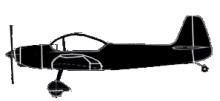
ASN Wikibase Occurrence # 173750
This information is added by users of ASN. Neither ASN nor the Flight Safety Foundation are responsible for the completeness or correctness of this information.
If you feel this information is incomplete or incorrect, you can submit corrected information.
| Date: | Monday 19 March 2001 |
| Time: | 10:45 |
| Type: |  Scintex CP.301C-2 Emeraude |
| Owner/operator: | Private |
| Registration: | G-ARSJ |
| MSN: | 581 |
| Year of manufacture: | 1961 |
| Engine model: | Continental C90-14F |
| Fatalities: | Fatalities: 0 / Occupants: 2 |
| Aircraft damage: | Destroyed |
| Category: | Accident |
| Location: | Garston Farm Airstrip, Marshfield, Chippenham, Wiltshire -
 United Kingdom United Kingdom
|
| Phase: | Approach |
| Nature: | Test |
| Departure airport: | Garston Farm Airstrip, Marshfield, Chippenham, Wiltshire |
| Garston Farm Airstrip, Marshfield, Chippenham, Wiltshire | |
| Investigating agency: | AAIB |
| Confidence Rating: |
Written off (damaged beyond repair) 19 March 2001, when crashed at Garston Farm Airstrip, Marshfield, Chippenham, Wiltshire. According to the following extract from the official AAIB report into the accident:
"The aircraft had undergone an extensive rebuild and a flight test was planned in order to obtain a Popular Flying Association (PFA) permit renewal under a 'Permission to Test Fly' issued by the PFA. The handling pilot, the aircraft owner, was accompanied by the PFA Inspector who acted as the flight test observer. Taxi and engine runs were carried out satisfactorily, however carburettor icing was experienced while on the ground but cleared normally with the application of carburettor heat. Full power checks were performed satisfactorily prior to take off.
The take off and climb to 1,000 feet agl were normal. A timed climb through 1,000 feet was carried out, following which the aircraft was levelled at 2,800 feet and power reduced to a cruise setting. As a precaution, carburettor heat was applied; slight carburettor icing appeared present, but cleared normally. Stall tests were then carried out, with carburettor heat applied before the engine power was reduced. Power was then increased to around 1800 rpm and a few gentle turns performed before recovery to Garston Farm.
During the return a simulated baulked landing was carried out, and the descent towards it involved reduced power with carburettor heat applied. Following a height loss of some 200 feet, full power was applied and the carburettor heat returned to 'cold' for the simulated go-around. After a brief climb of some 100 feet, the aircraft was levelled and power reduced to a cruise setting.
A couple of light 'pops' were then heard which the pilot considered were consistent with ice being ingested into the engine. The engine then began to run roughly. Carburettor heat was immediately re-applied, but without apparent effect on the engine which was running at about 1,600 rpm, and would not deliver full power. The engine oil pressure, temperature and fuel pressure were normal and there was about 3/4 of the tank of fuel remaining.
The aircraft was by this stage some 4 nm north of Garston Farm at around 1800 feet agl. The pilot considered attempting a forced landing in a field but the ground in the area was soft and recently ploughed and so he elected to return to the farm strip.
The engine continued to run roughly but with indicated temperatures and pressures normal. The pilot was familiar with the airfield and set the aircraft up high on final approach as he was aware of the possible effect of sink from high trees to the south east of the airfield. At around 300 feet the flight test observer, who was less familiar with the airfield, became concerned at the steep approach and selected full flap. At around 200 feet the combined effects of windshear and full flap caused a high rate of descent to develop. The propeller also stopped rotating at around 150 feet, causing additional drag.
The pilot turned the aircraft to the right before landing to avoid a low stone wall in the undershoot area; however the left wing then struck a small tree causing the aircraft to yaw left before landing in soft ground beyond the tree. Both main gears collapsed and the aircraft sustained extensive damage, but both occupants escaped injury and were able to vacate the cockpit through the canopy"
Damage sustained to airframe: per the AAIB report, the aircraft damage was "extensive". As a result, the registration G-ARSJ was cancelled by the CAA on 7 September 2001.
NOTE: The official AAIB report into the accident has the incorrect registration "G-ASRJ". G-ASRJ was a DeHavilland DH.89A DominIe, which was found to have major plywood rot at Netheravon early in 1970, (prior to C of A expiry on 27.3.70). The Registration G-ASRJ was cancelled on 16.2.70 as destroyed
Accident investigation:
 |
|
Sources:
1. AAIB: https://assets.publishing.service.gov.uk/media/5422ee5ced915d13710001e7/dft_avsafety_pdf_501098.pdf
2. CAA: https://siteapps.caa.co.uk/g-info/rk=ARSJ
3. http://www.avions-piel.com/avions-piel-gb/topic598.html
4. https://abpic.co.uk/pictures/view/1211214/
5. http://garstonfarm.co.uk/
6. http://gb.geoview.info/garston_farm_airstrip,27114057w
Revision history:
| Date/time | Contributor | Updates |
|---|---|---|
| 12-Feb-2015 01:47 | Dr. John Smith | Added |
| 13-Feb-2015 14:47 | Dr. John Smith | Updated [Narrative] |
| 13-Feb-2015 14:48 | Dr. John Smith | Updated [Aircraft type] |
| 13-Jul-2016 15:45 | Dr.John Smith | Updated [Time, Location, Departure airport, Destination airport, Source, Narrative] |
Corrections or additions? ... Edit this accident description
The Aviation Safety Network is an exclusive service provided by:


 ©2024 Flight Safety Foundation
©2024 Flight Safety Foundation